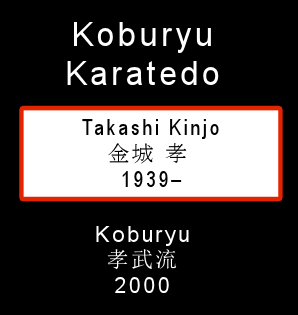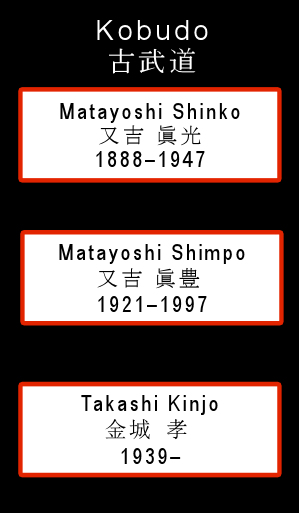About Kinjo Takashi
金城 孝
Kinjō Takashi (given in the Japanese manner, family name Kinjō followed by given name Takashi) was born on August 24,1939, in Naha City, Okinawa, Japan. In 1945, when he was just a young boy, he lost his father in the Battle of Okinawa. This battle is known as the “Typhoon of Steel” for the ferocity of the battle. He is proud to point to his father’s name on the Cornerstone of Peace monument in Peace Memorial Park, Okinawa, engraved with the names of over 250,000 dead from all countries involved in the battle.
The young Kinjō Takashi was naturally athletic, excelling in track events. He started his martial arts career in 1958, while still in high school. He brought this athleticism to his karate training, but is quick to point out that, while athletically gifted, he also trained harder than anyone else.
Sōke Kaichō Kinjō is renowned for his expertise in ieku, the oar. He has performed Tsuken Akachu no Ieku De and later his own version of the kata, Kōbu no Ieku, for many demonstrations through the years. A great showman, his versatility, speed and skill is second to none. More than showmanship, the kata of Kōburyū karate and kobudō demonstrate the practicality of the Okinawan fighting arts of old.
The Meaning of Ko
孝
The Japanese character for Takashi is 孝. In the way of Japanese kanji, this character has a second pronunciation of kō (rhymes with toe). It is the kō pronunciation that Sōke Kaichō Kinjō has used to identify his style, Kōburyū.
Kō has the meaning of “filial piety,” a concept that carries great meaning to Japanese people. Filial piety is a means to achieve family and social harmony. The concept comes from the teachings of Confucius. Defined as a child’s respect for his parents, it includes any relationship of a person to his parents, elders, ancestors and country. The filial child must care for his parents, owing them not only respect but love, support, loyalty and reverence.
Ko’s Fighting Way
孝武流
The name of Sōke Kaichō Kinjō’s karate and kobudō style is Kōburyū, which means Ko’s Fighting Way. Kōburyū includes karate and kobudō as one unified style.
The Meaning of Soke Kaicho
宗家会長
Sōke means originator.
宗家
Kaichō means chairman or president of an organization.
会長
Okinawa Kōburyū Karatedō Kobudō Kōbukai is the name of Sōke Kaichō Kinjō’s international karate and kobudō organization.
沖縄孝武流空手道古武道孝武会
The title, Sōke Kaichō, honors Kinjō Takashi as both the originator of the karate and kobudō style, Kōburyū, and the current head of the organization, Okinawa Kōburyū Karatedō Kobudō Kōbukai.
Soke Kaicho Kinjo’s Background
Karate
Sōke Kaichō Kinjō began his karate career in 1955, studying Shōrin Ryū under the renowned Shōrin Ryū master, Nagamine Shoshin, founder of Matsubayashi Shōrin Ryū. However, in 1959, Sokei Kaichō Kinjō turned to Uechi Ryū under Itokazu Seiki, another karate great and master of Uechi Ryū karate. Sōke Kaichō Kinjō’s lifelong study has been in the Uechi Ryū family of karate styles.
Sōke Kaichō Kinjō studied Uechi Ryū under Itokazu Seiki. Itokazu Seiki was a direct student of Kanbun Uechi and later of Kanei Uechi. Itokazu Seiki encouraged the young Kinjō Takashi, then a godan (5th degree black belt), to teach Uechi Ryū karate. Sensei Kinjō opened his first dojo in 1965, called Hantagawa Shureikan.
In 1978, a group of eight dojo, led by Itokazu Seiki and including Sensei Kinjō’s dojo, went back to the original style name, Pangainoon Ryū (半硬軟流). The rift was relatively quickly healed, but Pangainoon Ryū remained separate from Uechi Ryū until very recently. Sōke Kaichō Kinjō continued to teach Pangainoon Ryū with Itokazu Seiki as his teacher and mentor, eventually earning hanshi kyūdan in Pangainoon Ryū before Itokazu’s health declined.
Pangainoon (半硬軟) means “half hard soft.” It was a type of Chinese kung fu studied by Kanbun Uechi in China. The same kanji in Japanese are pronounced Hankōnan. In 1989, Sōke Kaichō Kinjō renamed Pangainoon Ryū, choosing to use the Japanese pronunciation of the kanji. The kanji for “half” was dropped to better indicate a balance between hard and soft. Kōnan Ryū, meaning “hard soft style,” was the name chosen by Sōke Kaichō Kinjō. More importantly, Kōnan Ryū, unlike Uechi Ryū or Pangainoon Ryū, included both karate and kobudō under one organization.
Kobudo
Historically, kobudō was never part of Uechi Ryū. Kinjō Takashi’s karate master, Itokazu Seiki, himself never studied kobudō. Indeed, Itokazu Seiki told his young karate protégé that practicing weapons would spoil his karate technique. In spite of this advice, in 1964, the young Kinjō Takashi began to study kobudō under Matayoshi Shimpo, then head of the Matayoshi family of kobudō and son of Matayoshi Shinko, who founded the Matayoshi family kobudō style.
Sōke Kaichō Kinjō earned hachidan (8th degree black belt) from Matayoshi Shimpo, but they eventually parted ways. Matayoshi Shimpo’s personal goal was to pass on the family kobudō style exactly as he was taught by his father, Matayoshi Shinko. Sōke Kaichō Kinjō’s desire to analyze and improve the movements of kobudō was in direct opposition to Matayoshi Shinpo’s chosen life’s work.
Sōke Kaichō Kinjō studied both karate and kobudō because he understood the benefits of studying both. Indeed, he came to feel that karate and kobudō were, like two halves of the same coin, inseparable. Therefore, in 1989, when Sōke Kaichō Kinjō established Kōnan Ryū (硬軟流), he included karate and Matayoshi kobudō under one organization. In the year 2000, when he created Kōburyū, he went one step further and included karate and kobudō as one unified style.
Soke Kaicho Kinjo’s Lineage
Karate

Uechi Kanbun is the founder of the Uechi Ryū family of Okinawan karate styles. Like most of the great Okinawan masters of the 18th and 19th centuries, Uechi Kanbun traveled to China to study the martial arts. In China he studied Pangainoon (半硬軟), a type of kung fu based on the movements of tiger, crane and dragon.
When Uechi Kanbun returned to Okinawa he refused for many years to pass on what he had learned. Eventually he was convinced to begin teaching, calling the style Pangainoon Ryū.
After the death of Uechi Kanbun in 1948, Uechi Kanei, eldest son of Uechi Kanbun and recipient of the style, renamed Pangainoon Ryū to Uechi Ryū (上地流) in honor of his father.
Uechi Ryū is one of the three major branches of Okinawan karate: Shōrin Ryū, Gōjū Ryū and Uechi Ryū. Like the other major branches of Okinawan karate, Uechi Ryū over time splintered into other closely related styles.
Until recently, the Uechi Ryū family of karate styles included Uechi Ryū, Pangainoon Ryū (1978), Kōnan Ryū (1989), Shōhei Ryū (1991) and Kōburyū (2000).

In preparation for the 2020 Olympics, there was a movement to unify the Uechi Ryū family of karate styles. Citing significant differences from Uechi Ryū, Sōke Kaichō Kinjō decided that Kōburyū should remain separate from Uechi Ryū.
Kobudo

Historically, kobudō was never part of Uechi Ryū. Itokazu Seiki, Kinjō Takashi’s karate master, himself never studied kobudō. Therefore, the young Kinjō Takashi, having and interest in kobudō, began to study under Matayoshi Shimpo, then head of the Matayoshi family of kobudō. His father, Matayoshi Shinko, founded the style.